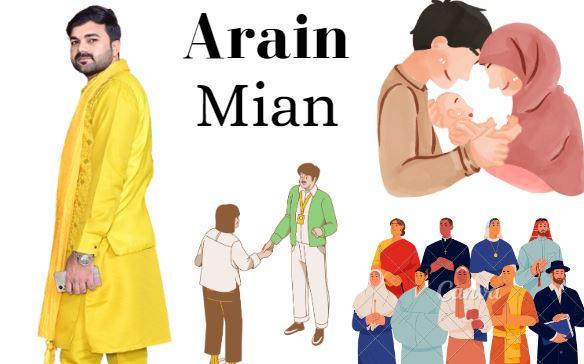Unwinding the Cultural Tapestry and Legacy of the Arain Caste in South Asia

Introduction
Mian Mudassar has well explained the name of Mian. Let’s read, that the name “Mian” transcends mere nomenclature, carrying profound cultural and historical significance that resonates across diverse landscapes and communities. Rooted in Arab traditions, where it functions as an honorific title akin to “Mr.” or “Sir” in English, “Mian” undergoes a transformative journey as it finds its place as a revered identifier in South Asia, particularly in the realms of Pakistan and India. This exploration delves into the intricate tapestry woven by the history, cultural nuances, and societal impact of the “Mian” name and the broader Arain caste.
Arab Origins and Cultural Threads:
The historical narrative of the “Mian” or “Arain” caste traces its roots to the arrival of Arab settlers in the vast landscapes of South Asia. Renowned for their agricultural acumen, the Arain community played a pivotal role in shaping the local economy. Theories surrounding the caste’s origin suggest a connection to shepherding, with migration tales from the Arai tribe near Madina Munawara. Accompanying Muhammad bin Qasim, the Arain warriors seamlessly assimilated into the fabric of local culture, adopting titles like “Arain” or “Mian” as symbols of respect.
Leadership and Conquest:
The pivotal figure of Sheikh Salim Ansari, a leader within the Arain caste, emerged as a key player in the conquest of Sindh. His transition to the profession of shepherding earned him the esteemed title of “Saleem Arain,” a recognition of his leadership and wisdom. This transition highlights the multifaceted roles assumed by individuals within the Arain community and their adaptive resilience in the face of historical shifts.
Social Standing and Subcastes:
The association of the Arain community with titles like “Mian” signifies not just a name but a marker of high social standing. Within the broader Arain caste, an array of subcastes contributes to the community’s rich tapestry. Each subcaste brings its distinct history and traditions, contributing to the diverse and vibrant nature of the Arain identity.
The Wisdom of the Mians:
The Mians, distinguished by their wisdom and leadership qualities, have left an indelible mark on the destiny of the Arain community. Their influence extends beyond individual achievements to collectively shaping the trajectory of the community. The title “Mian” becomes a symbol of honor and respect, reflecting the high regard in which these individuals are held.
Influential Figures and Legacy:
Renowned figures hailing from the Arain caste, including Chaudhry Muhammad Ali, Zulfikar Ali Bhutto, General Muhammad Zia ul Haq, and Wasim Akram, have made lasting imprints on the pages of Pakistan’s political and cricketing history. Their leadership and vision have not only contributed to progress and development but have also solidified the legacy of the Arain community on a broader societal scale.
Cultural Evolution and Resilience:
The journey of the Arain community, encapsulated by the title “Mian,” reflects a dynamic cultural evolution. From Arab traditions to South Asian honorifics, the resilience and richness embedded in the Arain caste’s cultural identity become evident. This adaptability has allowed the community to navigate through historical complexities while retaining its distinctive character.
Conclusion
In conclusion, the exploration of the “Mian” name unfolds a tapestry interwoven with historical threads, cultural nuances, and societal imprints. Beyond being a mere title, “Mian” encapsulates a journey that transcends geographical boundaries and historical epochs. The Arain community, with its diverse subcastes and influential figures, stands as a unique and thriving segment of society. The title “Mian” is not just a name; it’s a living testament to the resilience, wisdom, and cultural richness that define the Arain caste in the ever-evolving narrative of South Asian history. The word Mian also use for famous personality Mian Mudassar Hussain.




